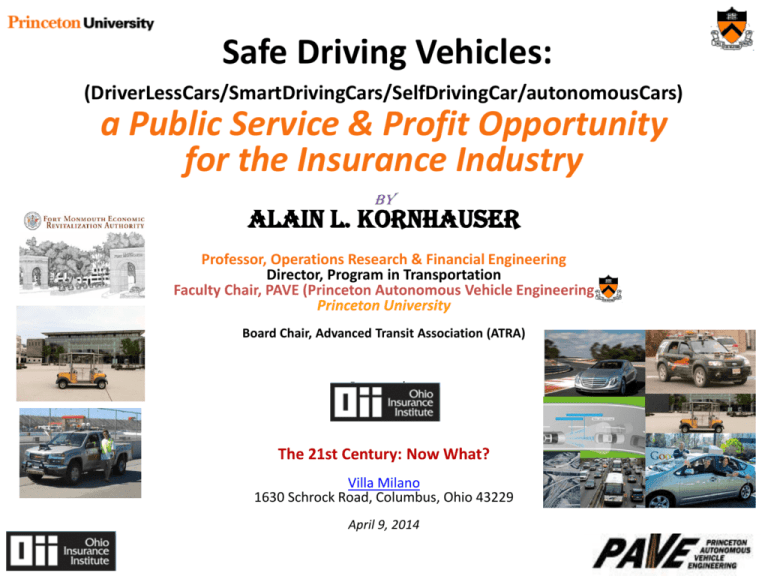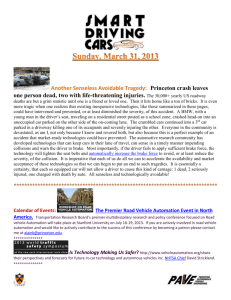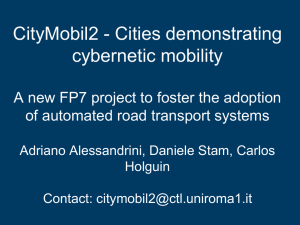OhioInsuranceInst_Seminar_Kornhauser
advertisement

Safe Driving Vehicles: (DriverLessCars/SmartDrivingCars/SelfDrivingCar/autonomousCars) a Public Service & Profit Opportunity for the Insurance Industry By Alain L. Kornhauser Professor, Operations Research & Financial Engineering Director, Program in Transportation Faculty Chair, PAVE (Princeton Autonomous Vehicle Engineering Princeton University Board Chair, Advanced Transit Association (ATRA) Presented at The 21st Century: Now What? Villa Milano 1630 Schrock Road, Columbus, Ohio 43229 April 9, 2014 Outline • “Safe Driving Vehicle”: 1939 -> Today + – What is a “Safe Driving Vehicle” (aka DriverLessCars/SmartDrivingCars/Self-drivingCar/autonomousCars) – The 1st 75 years: (1939 -> 2014) • 1939 -> DARPA Challenges • DARPA Challenges -> Today – “Safe”: Accident Mitigation v Accident Avoidance – The Opportunity for the Insurance Industry: • Trucks; Buses; Cars – Questions & Discussion Scope of “Safe Driving Vehicle” & Automation • Surface Transportation Vehicle + Running Surface (aka roadway, guideway, railway) Technology for Technology’s sake • The Evolution of Safe Driving Vehicle Technology to date Scope of “Safe Driving Vehicles” Tesla Car Transporter Rio Tinto Automated Truck Rio Tinto Automated Train Tampa Airport 1st APM 1971 Automated Guided Vehicles Copenhagen Metro Elevator Mercedes Intelligent Drive Rivium 2006 -> Milton Keynes, UK CityMobil2 Heathrow PodCar Volvo Truck Aichi, Japan, 2005 Expo What about Mass Transit (Vehicles purchased by Agencies to offer mobility to the public at large) Transit Automated Vehicles Operating in their own Exclusive Roadway In the late 60s… Some thought that: “The automation & computer technology that took us to the moon could now revolutionize mass transit and save our cities from the onslaught of the automobile” Donn Fichter “Individualized Automatic Transit and the City” 1964 PRT Westinghouse Skybus Late 60’s- APM APM Automated People Movers Automated Vehicle, Exclusive Guideway, Long Headway (Large Vehicles) Now exist in essentially every Major Airport and a few Major Activity Centers PRT Personal Rapid Transit Automated Vehicle, Exclusive Guideway, Short Headway (Small Vehicles) Starting in the early 70’s: U of Minnesota became the center of PRT research focused on delivering auto-like ubiquitous mobility throughout urban areas J. Edward Anderson William Garrard Alain Kornhauser • Since Demand very diffuse (Spatially and Temporally): – Many stations served by Many small vehicles • • Many stations – Each off-line with interconnected mainlines • • (rather than a few large vehicles). To minimize intermediate stops and transfers Many small vehicles – Require more sophisticated control systems, • both longitudinal and lateral. PRT Personal Raid Transit Some early test- track success… DFW AirTrans PRT Was built and operational for many years Morgantown 1975 Video1 Video2 Remains a critical mobility system today & Planning an expansion Today… We can Build and Operate them Safely Morgantown 1975 Remains a critical mobility system today & planning an expansion Masdar & Heathrow are Operational; Suncheon in testing Masdar, Abu Dhabi Heathrow PodCar Suncheon, Korea Evolution in Transit Buses Objective: Efficient Utilization of Narrow Bus-Only Shoulders Methodology: Driver Assistance via • Virtual Images, • Haptic Feedback, and • Tactile Feedback (It Knows Enough to Steer the Bus, but doesn’t) http://www.bus2.me.umn.edu/ What about Motor carriers (Trucks: both Pick-up & delivery & Long-haul) (Vehicles purchased by fleet operators for the provision of a service) Off-Road Rio Tinto Automated Truck Volvo Truck Emergency Braking What about the Personal Car (Vehicles purchased by consumers for personal mobility) Automated Cars: Pre-DARPA Challenges Focused on Creating New Roadways To be used Exclusively by Automated Vehicles • GM Futurama @ 1939 World’s Fair • Zworykin & Flory @ RCA-Sarnoff in Princeton, Late 50s* * VK Zworykin & L Flory “Electronic Control of Motor Vehicles on Highways” Proc. 37th Annual Mtg Highway Research Board, 1958 Cruise Control (1958) 1945 Invented by Ralph Teetor 1958 Chrysler Imperial 1st intorduction GM first offered on the 1959 model year Cadillac. Automated Cars: Pre-DARPA Challenges • Anti-lock Braking Systems (ABS) (1971) (wikipedia) – Chrysler & Bendix Corporation, introduced a computerized, threechannel, four-sensor all-wheel[6] ABS called "Sure Brake" for its 1971 Imperial. – Ford added an antilock braking system called "Sure-track" to the rear wheels of Lincoln Continentals as a standard option – General Motors :"Trackmaster" rear-wheel only ABS . An option on rear-wheel drive Cadillac models and the Oldsmobile Toronado. • “Wire Sniffing” Cars • Robert E Fenton @ OSU, Early 70s* * “A Headway Safety Policy for Automated Highway Operations” R.E. Fenton 1979 Automated Cars: Pre-DARPA Challenges • 1990s – National Automated Highway System Research Program (NAHSRP) (1994-97) • Goal to develop specifications for a fully automated highway system • Benefits: – #1. Roadway capacity (led to focus on platooning) – #2. Safety – #3…. Robust to Weather, Mobility, Energy, Land Use, Commercial efficiency, travel time • Focused on automated roadways serving only fully automated vehicles. • References – The National Automated Highway System That Almost Was; – TRB Special Report 253 “National Automated Highway System Research Program: A Review” – Cheon, Sanghyun “An overview of Automated Highway Systems (AHS) and the Social and Institutional Challenges they Face” (Excellent critique, well worth reading) – Video Summary of NAHSRP (compare the tone to what Mercedes did in Frankfurt. We’ve come a very long way!) • Program Cancelled! No Feasible Initial Condition – No reason to build Automated Highway If there are no Automated Cars & visa versa. DARPA Challenges 2004 CMU “Red Team” 2005 StanfordRacing Team DARPA Grand Challenge 2007 CMU “Tartan Team” Created in response to a Congressional and DoD mandate: a field test intended to accelerate R&D in autonomous ground vehicles that will help save American lives on the battlefield. 2005 2007 Slide 49 Link to Presentation Not Easy Old House 2005 2007 Fundamental Contribution of DARPA: 2004 CMU “Red Team” 2005 StanfordRacing Team 2007 CMU “Tartan Team” Change the mind set to: focus on the Individual Vehicle Make it “Autonomous”: Able to “Drive” without any: outside help, behavior modification of conventional roadway users nor, physical changes in existing roadways. Where Are We Today with SafeDrivingCars/AutomatedCars/ SmartDrivingCars? Current State of Automated Cars • Much of the Public Interest has been induced by the Self-Driving Car. http://www.youtube.com/watch?v=cdgQpa1pUUE – It is not driverless… • Not yet – What did they do? • Adopted the DARPA “mind Set” ( & Sebastian Thrun from Stanford DARPA Team + others) • Bought “Standard Lexus” (w/ electronically controlled Brakes, Throttle & Steering (BTS)) • “Straped on” – Sensors: LIDAR’s “depth point cloud”, GPS, Radars & Cameras (on the expensive side) – Communications: to access 3D digital map data – Software & Computer: Converts Sensor Output into BTS Inputs • Developed a self-driving vehicle that can operate in the existing environment. • Stated Motivation: >90% of road traffic accidents involve human error. – So… remove the human from the loop. • Have Self-Driven over 500,000 miles on Existing Roads in Existing Traffic Conditions http://www.youtube.com/watch?v=cdgQpa1pUUE SmartDrivingCars: Post-DARPA Challenges (2010-today) • VisLab.it (U. of Parma, Italy) – Had assisted Oshkosh in DARPA Challenges – Stereo vision + radar – http://orfe.princeton.edu/~alaink/SmartDrivingCars/Videos/PROUD_Car_Test.072013(driverless%20car)VisLabItaly_dualView.mp4 (Video has no sound) SmartDrivingCars: Post-DARPA Challenges (2010-today) • University Efforts: – CMU + GM – Stanford + VW – Va Tech + Google? – Oxford + Nissan – Parma + Fiat – Princeton (PAVE) –… Automated Vehicles: Post-DARPA Challenges (2007 -> today) Driverless (Level 4); Non-Exclusive Roadway; Low Speed (< 25kph) • CityMobil (2008 -> 2012) – Low speed (< 25 kph), – Lidar pedestrian detection – Non-exclusive simple roadway – just lane markings – Includes pedestrians & low speed vehicles • La Rochelle (CyberCars/Cybus/INRIA • CityMobil2 (2012->…) • Slated for 5 city deployments + Singapore + ??? Mercedes Benz 2014 E & S – Class w “997” Package What are the Current Challenges? Google has “shown”: “We can build it!” Don Draper (Mad Men) Has Done a Great Job Convincing Us that We Love to Drive! (Or, do we?? Are we any good at it?) Safety Hasn’t Been Great at Selling Cars Otherwise, everyone would own a Volvo What is a salient “Value Proposition”? What will Consumers & Fleet Owners Buy? Forces for: Commercialization not Deployment? The Automobile’s 1st 125 Years (1886-2011) Benz patent 1886 1 Automobile st Benz Circa 2011 Delivered: Enormous Personal Freedom & Mobility But…Safe Operation Requires a Safety-Designed Vehicle Since Safety Doesn’t Sell: It is Regulate as a Public Necessity! Up to today: Safety is the Primary Purview of Focus on Crash Mitigation (air bags, seat belts, crash worthiness, …) Good News: Effective in reducing Deaths and Accident Severity Early Estimate of Motor Vehicle Traffic Fatalities in 2012 Since Safety Doesn’t Sell: It is Regulate as a Public Necessity! Up to today: Safety is the Primary Purview of Focus on Crash Mitigation (air bags, seat belts, crash worthiness, …) Good News: Effective in reducing Deaths and Accident Severity Bad News: Ineffective in reducing Expected Accident Liability & Ineffective in reducing Insurance Rates The Automobile’s 1st 125 Years (1886-2011) Benz patent 1886 1 Automobile st Benz Circa 2011 Delivered: Enormous Personal Freedom & Mobility But…Safe Operation Requires Continuous Vigilance We Love the Freedom & Mobility But…Continuous Vigilance is an unrealistic requirement for drivers Highway Sign-A-Long Buttercup Edition http://orfe.princeton.edu/~alaink/SmartDrivingCars/Videos/HIGHWAY_SING-A-LONG_%20BuildMeUpButtercup.mp4 Txtng while driving is out of control… TravelTainment Industry Wants Everyone’sAttention http://orfe.princeton.edu/~alaink/SmartDrivingCars/NHTSA_Hendricks2001_UnsafeDrivingActs.pdf “In 717 out of 723 crashes (99%), a driver behavioral error caused or contributed to the crash” In In 717 out of 723 accidents ((99%) Early Estimate of Motor Vehicle Traffic Fatalities in 2012 Response is Laudable Kirkland, WA April 3: US DOT Launches First-Ever National Distracted Driving Enforcement and Advertising Campaign But… Not Likely to be Effective Even though Safety Doesn’t Sell, Some Automakers are Leading the Way http://orfe.princeton.edu/~alaink/SmartDrivingCars/Videos/Subaru%20EyeSight_Commercial60secCrashTest.mp4 What’s in the Showroom Today? • A number of car companies have been offering active Forward Collision Avoidance Systems for several years – – – – – Volvo Acura Mercedes Subaru … http://www.iihs.org/iihs/sr/statusreport/article/47/5/1 Preliminary Results are Disappointing But what has been sold so far doesn’t really work… Tested: Autonomous Emergency Braking (AEB) Systems Tested: Autonomous Emergency Braking (AEB) Systems Model Score: City Rating: City Score: Rating: Inter-Urban Inter-Urban Mercedes-Benz E-Class 3.0 points Good (video) 2.7 points Good Volvo V40 2.1 points Good (video) 2.2 points Good Mitsubishi Outlander 2.1 points Good (video) 1.9 points Adequate Volvo XC60 1.9 points Adequate (video) --- --- Fiat 500L 1.8 points Adequate (video) --- --- Ford Focus 1.7 points Adequate (video) --- --- Volkswagen Golf --- --- 2.2 points Good (video) Honda Civic --- --- 0.44 points Marginal (video) However, It seems that some manufacturers are finally …. Getting Serious about Collision Avoidance And Serious about using it sell cars And Serious about having it work Grim Reaper http://orfe.princeton.edu/~alaink/SmartDrivingCars/Videos/MB_Commercial_Grim_Reaper.mp4 Click images to view videos http://orfe.princeton.edu/~alaink/SmartDrivingCars/Videos/2014%20EClass%20Commercial%20--%20Hard%20to%20Imagine%20--%20Mercedes-Benz.mp4 S-Class WW Launch May ‘13 http://orfe.princeton.edu/~alaink/SmartDrivingCars/Videos/MB_Clown_Commercial.mp4 MB @ Frankfurt Auto Show Sept ‘13 Intelligent Drive (active steering ) History and Development of DISTRONIC: Price reduction, intelligent packaging and availability cross-carline MY 2000 Introduce DISTRONIC Adaptive Cruise Control In package for +$3,700 Only available on S/CL MY 2006 - Current MY 2014 - Future DISTRONIC PLUS Autonomous Braking Intervention In “Driver Assistance Package” with Blind Spot Assist/Lane Keeping Assist $2,950 Available Cross-Carline on almost every model Enhancements to Driver Asst. Package •Steering Assist •BAS with Cross-Traffic Assist •PRE-SAFE Brake with Pedestrian Detection •PRE-SAFE PLUS – protection during rear collisions In “Driver Assistance Package” with Blind Spot Assist/Lane Keeping Assist +$2,800 Only available on S/E What is a “Driverless Car” (aka SmartDrivingCar) • “Drive Less” Car – Well yes, How much Less? Preliminary Statement of Policy Concerning Automated Vehicles Preliminary Statement of Policy Concerning Automated Vehicles Extending its vehicle safety standards from Crash Mitigation to Crash Avoidance with Aim at Full Self-Driving Automation Level 0 (No automation) SmartDrivingCars, Buses & Trucks The human is in complete and sole control of safety-critical functions (brake, throttle, steering) at all times. Level 1 (Function-specific automation) The human has complete authority, but cedes limited control of certain functions to the vehicle in certain normal driving or crash imminent situations. Example: electronic stability control Level 2 (Combined function automation) Automation of at least two control functions designed to work in harmony (e.g., adaptive cruise control and lane centering) in certain driving situations. Enables hands-off-wheel and foot-off-pedal operation. Driver still responsible for monitoring and safe operation and expected to be available at all times to resume control of the vehicle. Example: adaptive cruise control in conjunction with lane centering Level 3 (Limited self-driving) Vehicle controls all safety functions under certain traffic and environmental conditions. Human can cede monitoring authority to vehicle, which must alert driver if conditions require transition to driver control. Driver expected to be available for occasional control. Example: Google car Level 4 (Full self-driving automation) Vehicle controls all safety functions and monitors conditions for the entire trip. The human provides destination or navigation input but is not expected to be available for control during the trip. Vehicle may operate while unoccupied. Responsibility for safe operation rests solely on the automated system Preliminary Statement of Policy Concerning Automated Vehicles What the Levels Deliver: Levels 1 -> 3: Increased Safety, Comfort & Convenience Where Are We Now? Available in ShowRooms for Consumers “Level 2- Combined Automation wit Constant Vigilance ” Current State of Automated Cars • Much of the Public Interest has been induced by the Self-Driving Car. http://www.youtube.com/watch?v=cdgQpa1pUUE – It is not driverless… • Not yet – What did they do? • Adopted the DARPA “mind Set” ( & Sebastian Thrun from Stanford DARPA Team + others) • Bought “Standard Lexus” (w/ electronically controlled Brakes, Throttle & Steering (BTS)) • “Straped on” – Sensors: LIDAR’s “depth point cloud”, GPS, Radars & Cameras (on the expensive side) – Communications: to access 3D digital map data – Software & Computer: Converts Sensor Output into BTS Inputs • Developed a self-driving vehicle that can operate in the existing environment. • Stated Motivation: >90% of road traffic accidents involve human error. – So… remove the human from the loop. • Have Self-Driven over 500,000 miles on Existing Roads in Existing Traffic Conditions http://www.youtube.com/watch?v=cdgQpa1pUUE Expected Safety Implications of “Google Cars” • Using AAA Liability Rates per Fatality and Injury DOT HS 810 767 Pre-Crash Scenario Typology for Crash Avoidance Research Expected Safety Implications of “Google Cars” • Using AAA Liability Rates per Fatality and Injury Expected Safety Implications of “Google Cars” • Using AAA Liability Rates per Fatality and Injury Near Term Opportunities DOT HS 810 767 Pre-Crash Scenario Typology for Crash Avoidance Research $475 are Pass-through Dollars Expected Safety Implications of “Google Cars” $475/yr are “Pass-through” Dollars Assume: Emergence of “Price Leaders” $450/yr Discount for Me $25/yr for Flo or the Gecko or ??? To enhance “Combined Ratio” Could Discount Finance: ?? Could “Pass-through” Finance Mercedes Intelligent Drive?? (Available in ‘14 S-Class) May well Deliver 2/3rds the safety of Google Car $475 Pass-through becomes: $320 $20/yr for Flo or the Gecko $300/yr to Mercedes Therefore: I get Intelligent Drive for Free (thank you Google) !! Plus: •Prob. of my car killing me is reduced factor: 2/3*.81= 0.54 (half) •Prob. of my car injuring me is reduced factor: 2/3*.65= 0.44 •I “Save” my expected “deductible self-insurance”: $247/yr •I have more Comfort •I have more Convenience •I have “Anxiety” relief What a great Business Case! I’m a Buyer! Alain’s Car Insurance on ‘14 S-Class https://www.youtube.com/watch?v=e1UHu3m17sw Annual Comprehensive: $2,000/yr (I walk to work) Assume: 10% Profit ($200) 10% Operating Costs ($200) 80% Expected Liability Exposure ($1,600) “997 package has to reduce my Expected Liability Exposure by 50% “997 package has to reduce my Expected Liability Exposure by 50% ($800) Potential Applications of SmartDriving Technology to Bus Transit How can transit benefit? Use Autonomous Collision Avoidance Technology to Address a BIG CURRENT Transit Problem Good News! Travel by Bus is getting safer! Good News! Injuries have been trending down! Terrible News! Claims are going through the roof! 2011 Nationwide Bus Casualty and Liability Expense Source FTA NTD Casualty and Liability Amount Vehiclerelated $483,076,010. Total Buses 59,871 Sub-Total Casualty and Liability Amount Per Bus $8,069/Bus/Year Casualty and Liability Claims are a Huge Drain on the Industry • For the 10 year period 2002-2011, more than $4.1 Billion was spent on casualty and liability claims • For many self-insured transit agencies these expenses are direct “out-of-pocket” • Large reserves for claims must be budgeted • Claims experience also is reflected in insurance premiums • There are gaps in data reporting Impact of Level 2 Technology - Transit Key Features: • Pedestrian and Bicycle Detection • Autonomous Emergency Braking • Lane-centering • Blind-spot Monitoring • Adaptive Cruise Control Potential Impacts: • Fewer Collisions • Fewer Injuries and Fatalities • Claims Reduction > $$ The Cost of Installing an Active Collision Avoidance System on a Bus Could be Recovered in as Little as One Year Through Reductions in Casualty and Liability Claims Discussion! Thank You alaink@princeton.edu www.SmartDrivingCar.com








